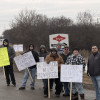Western States’ event draws 14 owner representatives
WHILE THERE WAS much to discuss at the 11th Annual Western States Tripartite Conference July 21-23 in Coeur d’Alene, Idaho, considerable attention was given to the Boilermakers’ Helper program. A panel led by IVP-WS J. Tom Baca discussed why the program was needed, the initial skepticism it met and the benefits that are being demonstrated by the program.
Essentially, the Helper is a new classification developed to achieve two goals: 1) serve as a proving ground for new apprentice applicants and 2) make union Boilermaker crews more competitive by including lower-rate, less-skilled workers among the crews to handle tasks that do not require the expertise of, say, a high rigger or a tube welder.
Also sitting on the panel were Jon Maring, PG&E, Owner Chairman; Larry Jansen, ARB Vice President, Contractor Chairman; Jim Cooksey, AIP/ International Rep, Union Chairman; and Collin Keisling, Western States Joint Apprentice Committee Coordinator.
IVP Baca noted the Helper classification makes for more reliable assessment and qualification of future apprentices. Helpers work in the field as pre-apprentices before they are indentured into the four-year apprentice program. This experience will either convince them that this is the career path they want or dissuade them from going any farther, he said, adding that those Helpers who decide to enter the apprentice program therefore are more motivated and more likely to succeed.
Baca said the lower starting wage rate and deferral of full benefits also brings down the cost of the overall Boilermaker crew, making union contractors more competitive with nonunion contractors while “maintaining the advantage of highly-skilled journeyman Boilermakers who have the best craft training in their field.”
Efforts to expand the Boilermaker workforce to handle upcoming projects also drew broad discussion. Keisling said the Western States apprenticeship program is “the healthiest it’s ever been” and that apprentices are receiving “well over the required 140 hours of training.”
Baca noted that the Joint Apprenticeship Program would soon break ground on a 15,000-square-foot, state-of-the-art training center in Salt Lake City, Utah. Contract documents for the property purchase were signed during the conference.
Guest speakers for the event included Dr. Peter Philips, a labor economist at the University of Utah, who addressed prevailing wage and right to work issues; Per Lorentzen, Chevron Construction Manager for the Richmond, Calif., Refinery, who presented an overview of anticipated refinery work; and Robbie Hunter, President of the California State Building and Construction Trades Council, who discussed industrial issues in California.
A total of 14 owner representatives attended the conference, setting a new record for the event.







